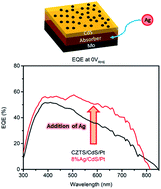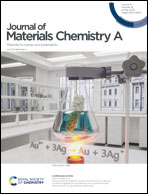Improving the interfacial properties of CZTS photocathodes by Ag substitution†
Abstract
Cu2ZnSnS4 (CZTS) is a promising photocathode in water splitting systems due to its appropriate conduction band position with the water reduction potential, suitable band gap and high absorption coefficient. However, CZTS has yet to demonstrate unbiased solar to hydrogen efficiency above 1% in a photocathode–photoanode tandem setup unlike its CuInGaSe2 chalcogenide counterpart due to its low onset potential and photocurrent. This low onset potential and photocurrent is believed to be due to the high density of defects in CZTS and at the CZTS/CdS interface which limits the open-circuit voltage in CZTS solar cells. In this work (AgxCu1−x)2ZnSnS4 (ACZTS) with Ag+ partially replacing Cu+ is fabricated by a solution process and investigated as a photocathode. Our ACZTS/CdS/Pt photocathode yields a maximum photocurrent of 17.7 mA cm−2 at 0 VRHE with 4% Ag (x = 0.04) and a maximum onset potential of 0.85 VRHE with 8% Ag (x = 0.08), which is a substantial improvement from our CZTS/CdS/Pt photocathode that has a photocurrent of 13 mA cm−2 and an onset potential of 0.65 VRHE. A combination of incident photon to current efficiency (IPCE) measurements done in a photoelectrochemical (PEC) and photovoltaic (PV) setup attributes the improvement to the interface properties. Other PV measurements such as capacitance–voltage profiling (CV) and Mott–Schottky measurements reveal a lower apparent carrier concentration and higher built-in voltage of ACZTS.



 Please wait while we load your content...
Please wait while we load your content...